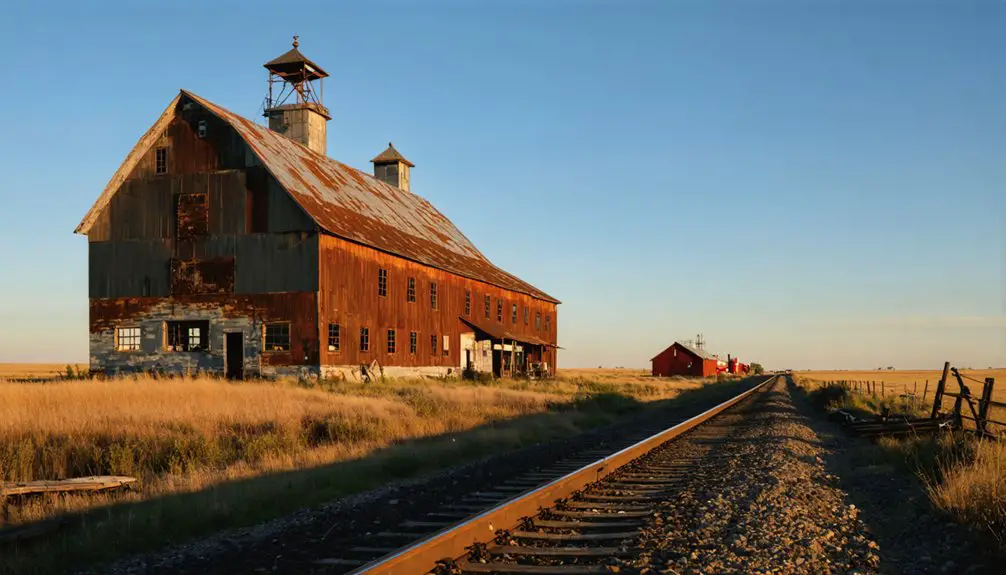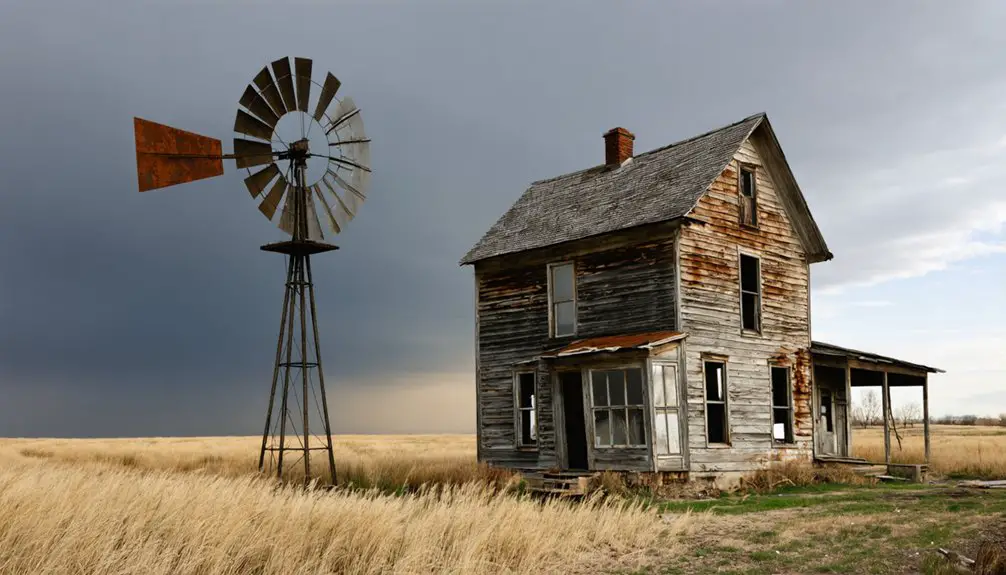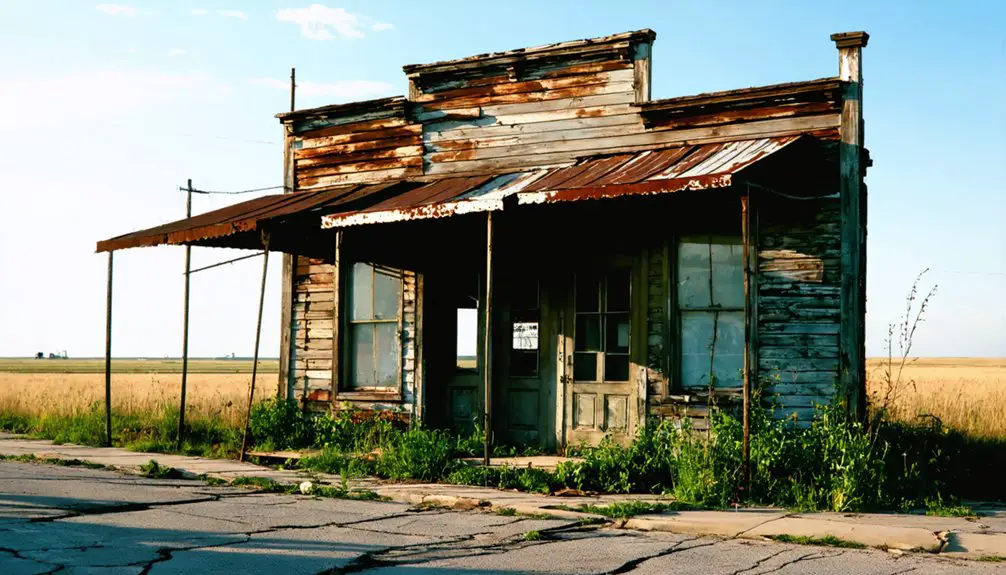You’ll find Breslau’s remains in Pierce County, Nebraska, where German immigrants established this distinctive settlement in the early 1900s. Named after the Prussian city of Breslau (now Wrocław, Poland), the town flourished briefly as a Chicago, Burlington and Quincy Railroad stop, with its post office operating from 1911 to 1935. While the community’s physical structures have largely vanished, Breslau’s story reveals fascinating details about Nebraska’s German heritage and railroad history.
Key Takeaways
- Breslau was founded by German immigrants in Pierce County, Nebraska, and named after Breslau, Prussia (now Wrocław, Poland).
- The Chicago, Burlington and Quincy Railroad established Breslau as a transportation hub in the early 1900s.
- The town’s post office operated from 1911 to 1935, marking its peak period before declining into a ghost town.
- Agricultural practices and German cultural traditions shaped the community’s daily life during its active years.
- Breslau’s abandonment reflects broader economic shifts that affected many Nebraska railroad towns during the early 20th century.
German Heritage and Town Origins
While many Midwestern settlements emerged during the railroad expansion of the late 1800s, Breslau, Nebraska‘s story began specifically with German immigrants who named their new community after Breslau, Prussia (now Wrocław, Poland).
Located in Pierce County, the town served as a symbol of the strong ethnic identity of its German settlers, who sought to preserve their cultural traditions in the American Plains.
German immigrants carved out their own cultural haven in Pierce County, preserving their heritage while building a new American home.
You’ll find that these determined immigrants established Breslau during a significant wave of German migration to the Midwest, drawn by the promise of fertile farmland and the freedom to build their own close-knit community.
Like its namesake city that had fallen under Habsburg rule in 1526, this American town developed its own distinct cultural identity.
The town’s post office operated from 1911 to 1935, marking Breslau’s most active period when German language, customs, and religious practices flourished among its residents.
The establishment of the Chicago, Burlington and Quincy Railroad through the area played a crucial role in the town’s development and connection to larger markets.
The Railroad’s Vital Role
Once the Chicago, Burlington and Quincy Railroad established its line through Pierce County in the early 1900s, Breslau emerged as a strategic transportation hub for the region.
Railroad expansion brought German settlers who quickly recognized the area’s potential, establishing farms and businesses around the tracks.
Just as Breslau’s early growth had transformed it from a small settlement into a major European city by 1910, this Nebraska town showed similar promise in its early days.
Like its Polish namesake city that features twelve islands on the Oder River, this Nebraska town demonstrated similar geographic advantages for transportation.
You’ll find that Breslau’s economic sustainability depended entirely on its rail connection. The railroad enabled farmers to ship their products to distant markets while attracting merchants who served rail workers and travelers.
By 1911, the town’s significance led to a post office opening. Even U.S. Route 20’s placement near Breslau reinforced its role as a transport center.
However, when rail traffic declined, the town’s fortunes followed. The post office closed in 1935, marking the beginning of Breslau’s transformation into a ghost town.
Life in Early Breslau
Early life in Breslau revolved around its German immigrant population, who brought their cultural traditions from their namesake city of Breslau (now Wrocław, Poland) to the Nebraska plains.
You’d find a close-knit community where agricultural practices shaped daily routines, with farmers and ranchers working together to manage crops and prepare cattle for market.
Much like the residents of abandoned Monowi nearby, the people of Breslau relied heavily on each other for survival and community support.
The families built sturdy log cabins as their first homes, following the typical frontier dwelling patterns of the American West.
- Community gatherings centered on church events and seasonal celebrations, including traditional German Christmas festivities with pine trees and candles.
- Residents supported each other through cooperative farming, hunting, and resource sharing.
- Simple frame and brick buildings clustered near U.S. Route 20 and the railroad.
- Local trades included blacksmiths, carpenters, and general store operators serving the community’s needs.
Despite harsh frontier conditions, this unincorporated settlement of roughly 100 residents maintained strong social bonds through mutual support and shared traditions.
Post Office Operations and Decline
The heart of Breslau’s communication system emerged with its post office in 1911, coinciding with the arrival of the Chicago, Burlington and Quincy Railroad. For 24 years, this significant hub served the area’s German immigrant population, providing essential postal services and maintaining community connectivity throughout Pierce County and Nebraska.
You’ll find the post office’s role was particularly important in Breslau’s unincorporated setting, where it stood as one of the few official institutions binding the community together.
But by 1935, declining population and shifting transportation routes led to its closure. When postal operations moved to nearby Plainview and Osmond, you could see Breslau’s transformation beginning.
The post office’s closure marked a turning point – without this indispensable lifeline, Breslau’s path toward ghost town status accelerated, highlighting how essential postal infrastructure was to rural survival.
Legacy Among Nebraska Ghost Towns
Breslau’s story mirrors dozens of Nebraska ghost towns that emerged during the state’s territorial expansion between 1850-1870.
Like many of its contemporaries, including Oreopolis and Dannevirke, Breslau represents the complex cultural memory of Nebraska’s settlement period.
Similar to Spring Ranch’s role as a Pony Express stop, these communities were vital transportation hubs for early settlers.
The town faced economic shifts that led to its eventual abandonment, following patterns seen across the state.
You’ll find that these vanished communities left lasting marks through their community institutions and immigrant heritage.
- Former brick buildings and educational facilities show the settlers’ determination to establish permanent roots.
- Cultural influences, like those seen in Danish-founded Dannevirke, shaped town identities and naming practices.
- Churches, schools, and newspapers served as essential social anchors before decline.
- Physical remnants continue telling stories of pioneer life and early economic aspirations.
Today, Breslau stands among Nebraska’s ghost towns as a reflection of the ambitious spirit of territorial expansion and the harsh realities that challenged frontier communities.
Frequently Asked Questions
Are There Any Remaining Structures or Ruins Still Visible in Breslau Today?
You won’t find any remaining structures or visible ruins there today – decades of abandonment, harsh weather, and lack of preservation have erased virtually all physical traces of what once stood.
What Was the Peak Population of Breslau During Its Most Prosperous Years?
Like a small seed that never grew into a mighty oak, your town’s historical significance peaked at roughly 100 residents during its most prosperous years, reflecting modest Breslau demographics in Nebraska’s railroad era.
Did Any Notable Historical Events or Incidents Occur in Breslau?
You won’t find any major historical events or notable residents documented in Breslau’s history. The town maintained a quiet existence focused on local farming until its decline following the 1935 post office closure.
What Businesses and Services Existed in Breslau Besides the Post Office?
Where there’s smoke, there’s fire, and you’d find a bustling blacksmith shop, general store stocking groceries, grain storage facilities, and railroad-linked businesses serving the farming community alongside the Chicago, Burlington & Quincy tracks.
Can Visitors Access the Former Breslau Town Site on Public Land?
You’ll need to verify public access before visiting, as land ownership status isn’t clearly documented. Contact Pierce County officials for visitor guidelines since the site’s location near Route 20 doesn’t guarantee entry.
References
- https://history.nebraska.gov/wp-content/uploads/2017/12/doc_publications_NH1937GhostTowns.pdf
- https://nebraskarules.tripod.com/id11.html
- https://en.wikipedia.org/wiki/Breslau
- https://www.youtube.com/watch?v=l3s2qhSxis8
- https://www.youtube.com/watch?v=aynn14t_3k4
- https://repositories.lib.utexas.edu/bitstreams/fe39c22c-930e-4353-a22c-0acb2b1540d1/download
- https://nebraskahighway20.com/nebraska-counties/pierce-county-nebraska/breslau-nebraska/
- https://en.wikipedia-on-ipfs.org/wiki/Breslau
- https://mki.wisc.edu/german-american-resources-at-the-max-kade-institute-family-histories-and-archival-materials/
- https://www.wikiwand.com/en/articles/Breslau



